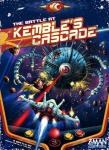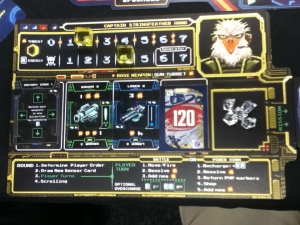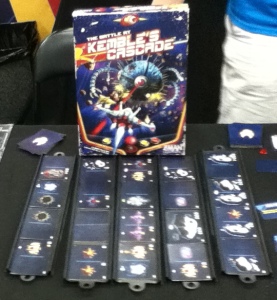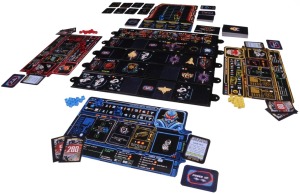Unplugged: The Battle at Kemble’s Cascade (Boardgame)
 Boardgames have turned into video games (see Civilization) and video games have made their way into a boardgames (Doom, Starcraft, Age of Empires III). To my knowledge, The Battle at Kemble’s Cascade is the first boardgame designed to capture the nostalgia of playing an old arcade scrolling shooter. Yes, in the game each player controls a fighter pilot desperately trying to defeat enemy ships and collect powerups while avoiding enemy fire. There is even a boss battle at the end, don’t expect to get through the game without using up several of your (albeit unlimited) lives. As a boardgame, Kemble’s Cascade may not quite appeal to the typical strategy boardgamer, but to gamers who remember the arcade shooter genre fondly it manages to recreate much of the experience in boardgame form.
Boardgames have turned into video games (see Civilization) and video games have made their way into a boardgames (Doom, Starcraft, Age of Empires III). To my knowledge, The Battle at Kemble’s Cascade is the first boardgame designed to capture the nostalgia of playing an old arcade scrolling shooter. Yes, in the game each player controls a fighter pilot desperately trying to defeat enemy ships and collect powerups while avoiding enemy fire. There is even a boss battle at the end, don’t expect to get through the game without using up several of your (albeit unlimited) lives. As a boardgame, Kemble’s Cascade may not quite appeal to the typical strategy boardgamer, but to gamers who remember the arcade shooter genre fondly it manages to recreate much of the experience in boardgame form.
The premise of the game is simple, each player controls a single ship they can move around the central board. Ships start with a basic weapon, can move one space, and have a supply of energy. Energy is both a ship’s health and extra resource. By spending extra energy a ship may move twice or fire twice (or both!) However, ships do not recover energy automatically, so it can be difficult to regain lost energy without simply dying; and your ship WILL die. Expect to die a few times during the game. Any player with a ship still alive on the board scores two points when another player’s ship dies. This is one of the best (and most common) ways to score points in the game. Other ways to score points include destroying enemies, upgrading one’s ship, and interacting with a few special spaces on the board.
The uniqueness of the game lies in the game board. The board is usually a 5×8 grid containing enemies, asteroids, powerups, and other special spaces. At the end of each round (once all players have moved), the bottom row of cards are removed and a new row of cards are added to the top. Thus the game board “scrolls” downward while players fly upwards. Any ship on the bottom row when it is removed is “pushed” up a row – possibly damaging that ship if it is pushed into an obstacle. This scrolling mechanism is the key to giving the game its old-school arcade shooter feel. Most of the game board is open space, enemy ships, or indestructible asteroids. However, some spaces contain power-ups, extra energy, teleporting powers, or opportunities for additional points. My favorite part of the board is the end of the game where a climactic battle is fought against a “boss ship” (one of four in the game) that spans the entire top of the board and may even be two rows deep.

During the game, ships have four “slots” that can be upgraded with new types of weapons and abilities. These may include increasing one’s maximum energy, improving one’s engines, and acquiring entirely new types of weapons. The three upgraded weapon types are Lasers (which can shoot multiple times), Radiation (which shoots through most things), and Missiles (which do additional splash damage.) Each weapon type can be upgraded multiple times to be even more powerful. Thankfully, no upgrades are lost when a ship dies. “Shopping for weapons” only happens when a player is off-board after dying or when one gives up an entire turn to shop and regain a little bit of energy. Thus, dying is often a perfect chance to score some upgrades.
Other chances to score during the game include achievements and personal missions. Each player gets a mission at the start of the game which will reward a player with points if it is completed. Missions typically emphasize some part of the game that a player might not normally perform. I managed to get the “ram at least four other ships with your ship” card two times… Not hard to complete but it does make for a couple glorious deaths. Other missions include shopping multiple times (more than one might normally do) or being “bumped” up off the bottom row a required number of times. Achievements represent those achievements that can be completed while playing video games. Four achievements are revealed at any one time and are replaced whenever they are completed. Sample achievements include coming to a stop just in front of a black hole, hoarding a specified number of monies, or cruising to the top row of the board to be threatened the next turn.
Threat is an important and somewhat unique part of the game. At the end of a player’s turn, the board is scanned for objects that provide “threat”, symbolized by a small explosion symbol. The more symbols adjacent to your ship, the higher your threat. The NEXT turn, you start with that amount of threat. Each space moved reduces your threat by one point. (The idea is that threat are bullets headed your way and moving gives you a chance to dodge.) At the end of your turn, you lower your energy by the amount of threat you have left. If that reduces you to zero, you blow up (other players on the board get 2 points) and return at the bottom of the board on the start of your next turn. If you manage to survive your threat, a new threat total is determined at the new location and you have your next turn to “dodge” that threat down to a manageable level.
There are a few other details here and there (players use special cards to “bid” for turn order – high cards going first) but that is the gist of the game. Fly your ship around, blast at things and other players. Earn monies and spend them on ship upgrades. All the while trying to finish your mission and collect those achievements. At the end of the game, a giant boss (one of four) appears across an entire row and slowly marches towards the players. When there are only two rows left on the board, the game ends.
Thoughts about the game
I am a poor everyman to judge this game. As a huge fan of old arcade games, this was a title I looked forward to with much anticipation. On the whole, I am very pleased. The game is a bit complex and thus lasts longer than one might expect from a “spaceship action game”. The game is a more tactical than simply a shooting fest. However, it remains fun. I played a five person game with three kids and no one got bored along the way. It is not a “filler” but as long as players don’t suffer from AP (and there shouldn’t be too much) it moves along at a good pace.
The game clearly has some randomness: primarily in the turn order cards (players only get to choose from two at any one time) and in the achievements. Since achievements are automatically refilled they can sometimes be completed by a player as soon as they are revealed. The turn order cards seem to be used sufficiently frequently (and you can save up one card) so that their random effect evens out. The achievements are more of a problem. Even though they only award a few points, many games end fairly close and getting “lucky” with achievements can be enough to pull ahead. Of course, player against player interactions can attempt to compensate for this but only to a limited extent. While it affects players equally, I have found the money supply to vary greatly from game to game (perhaps it is partially a function of the number of players.) In one game nearly everyone had one or more upgrades fully maxed out, whereas in another game players were hard pressed to upgrade very far at all.
Surprisingly, I found the inter-player combat to be very well balanced. One can stay “out of the fight” on one section of the board in order to score the most points when dueling players blow up. However, attacking other players also grants one points when that player finally dies. In one case you are earning when every ship dies, in the other case you earn more for each death.
Verdict:
It should be fairly clear for you to identify if this game is for you. It does a great job of fulfilling expectations about the theme of the game. Although 90 minutes might seem long for an “arcade game,” it moves at a decent clip so that players are able to stay focused and enjoy the action. There are many tactical decisions available, almost every turn when one must decide who to attack and how much energy to burn. However, long-term strategic decisions are only found in the choices made for ship upgrades. Watching other players easily grab achievements before you have a chance can be a bit frustrating, but they rotate enough so that it evens out a bit. And if it doesn’t, shooting other players is a fine way to work off some angst. The game isn’t 100% perfect, but I’m not a game designer so I’m not sure if I could make it any better. As a huge fan of the theme, the game easily earns a long-term spot on my gaming shelf.
Kid Factor:
No real issues in terms of appropriate content, although the direct player vs player aspects may cause friction in some households. The rules are not complex, so a young grade school child should have no problems following them, although at 25-30 minutes per player they may have a hard time keeping focus. However, to do well with tactics and other aspects of the game (upgrading, etc…) I would think 7 or 8 years old would be a good start.







Discussion Area - Leave a Comment